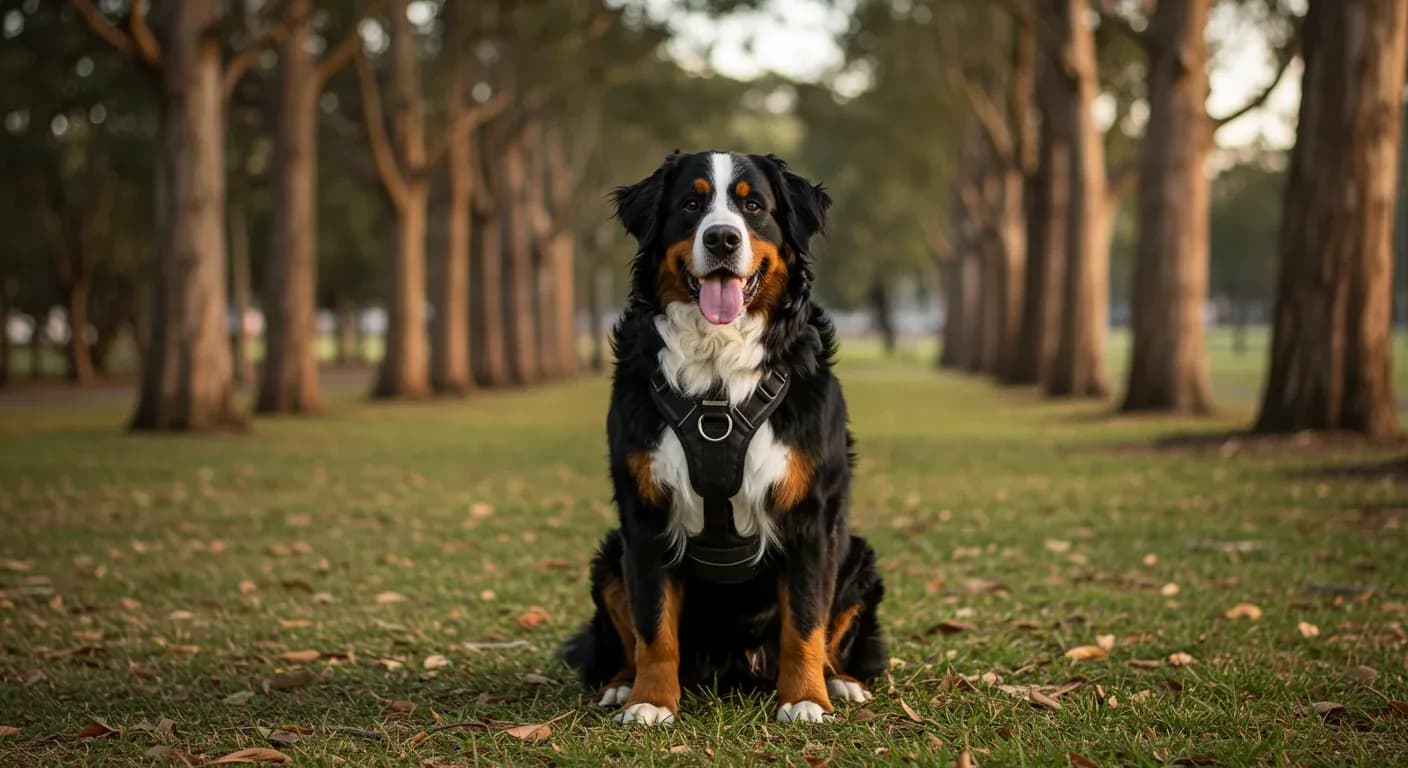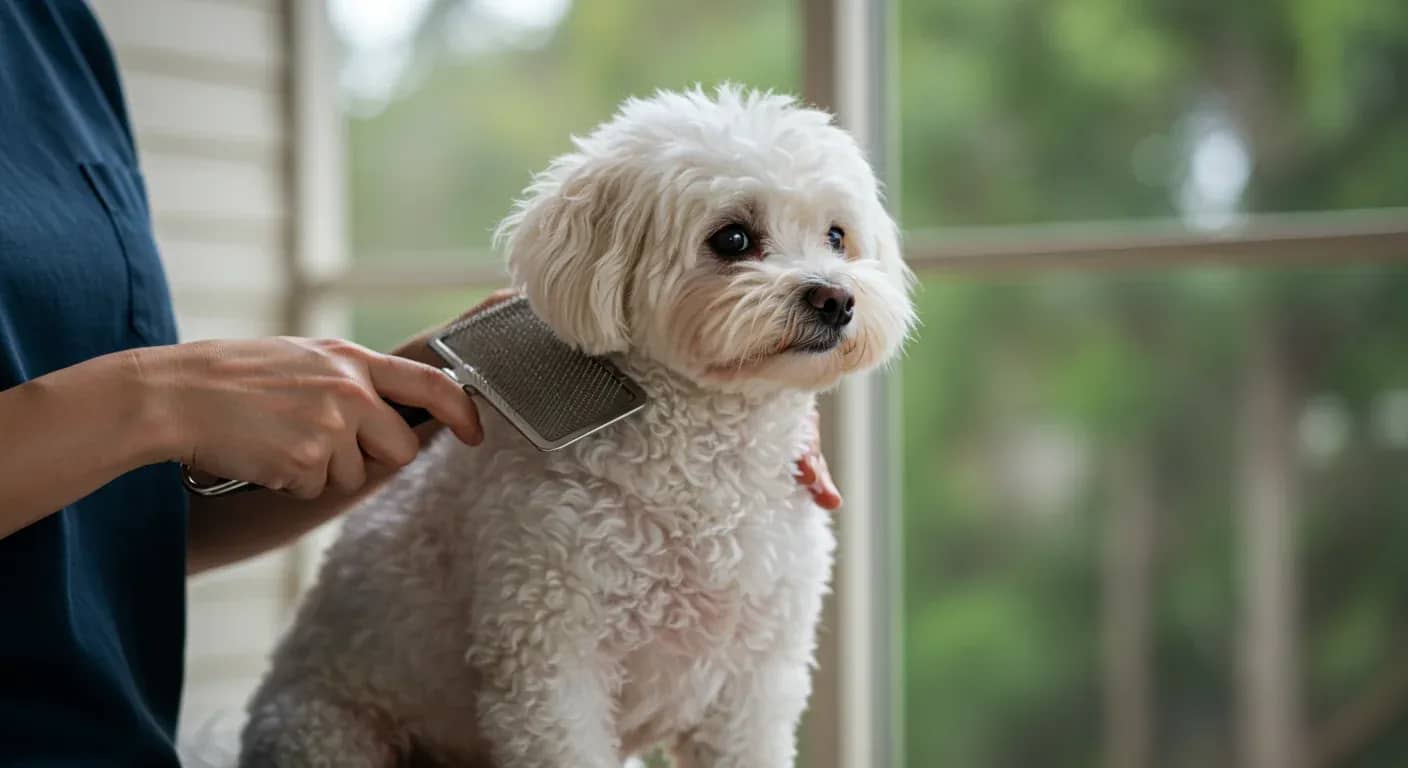At a glance
- Bernese Mountain Dogs need harnesses with multiple adjustment points due to significant size variation within the breed
- Breathable materials like mesh help prevent overheating in dogs with thick double coats
- No-pull harnesses with front attachment points provide better control for strong pullers without choking
- The Elite Field Padded Reflective No-Pull Harness offers the best overall combination of comfort, adjustability, and control
Understanding your dog's unique harness requirements
You might notice that finding the right harness for your Bernese Mountain Dog feels more challenging than it should. These gentle giants present unique fitting challenges that go beyond simply choosing a "large" size. Their substantial build, thick double coat, and considerable strength mean that what works for other large breeds might not be the best choice for your dog.
The reality is that Bernese Mountain Dogs vary significantly in size, even within the breed standard. A harness that fits one dog perfectly might be completely wrong for another of the same age and gender. This variation makes accurate measurement absolutely essential before you start shopping.
Their thick double coat adds another layer of complexity. Many owners discover that their dog overheats quickly in padded harnesses, especially during warmer months. The coat can also mat or become damaged where harness straps sit, particularly if the fit isn't quite right.
Getting the measurements right

Before you even look at harness options, you'll need two key measurements: the girth (circumference just behind the front legs) and the neck measurement. Use a flexible measuring tape and measure when your dog is standing naturally. Don't pull the tape tight, but don't leave it loose either.
Record these measurements and keep them handy when shopping. Many Bernese Mountain Dog owners find that their dog falls between standard sizes, which is why adjustability becomes so important. Look for harnesses with multiple adjustment points rather than just one or two basic straps.
If you have a puppy, plan to remeasure every few weeks. These dogs grow rapidly, and a harness that fits perfectly today might be too small within a month. Some owners find it worthwhile to invest in a more expensive, highly adjustable harness that can accommodate growth spurts.
Material choices that work for thick coats
The material you choose can make the difference between a comfortable walk and an overheated, uncomfortable dog. Lightweight, breathable materials like mesh offer excellent ventilation, though they typically provide less padding. For dogs with thick coats, this trade-off often works in their favour.
Nylon harnesses are durable and widely available, but they're less breathable than mesh options. If you choose nylon, look for designs with minimal coverage to allow better air circulation. Neoprene provides excellent padding and comfort, but it can trap heat against your dog's body, potentially causing overheating during active walks.
Leather harnesses offer durability and a classic look, but they require regular maintenance and can be quite heavy. For most Bernese Mountain Dogs, especially those who walk daily, lighter synthetic materials prove more practical for regular use.
Control features for strong dogs

Many Bernese Mountain Dog owners worry when their gentle giant suddenly becomes a powerful puller on walks. The solution often lies in choosing a no-pull harness with a front attachment point. This design gently redirects your dog when they pull forward, discouraging the behaviour without the choking effect of a traditional collar.
A front attachment point works by turning your dog slightly toward you when they pull, naturally slowing their forward momentum. This approach is much more effective than simply trying to hold back a determined dog who might weigh 45 kilograms or more.
For well-trained dogs who walk nicely on lead, a back attachment point works perfectly well and feels more natural for both dog and handler. Some harnesses offer both options, letting you choose based on your dog's behaviour and your training goals.
Whatever style you choose, pay attention to the hardware quality. Look for sturdy metal D-rings and reinforced stitching at stress points. These dogs can generate significant force when they're excited or distracted, and cheap hardware simply won't hold up over time.
Top harness recommendations for the breed
The Elite Field Padded Reflective No-Pull Harness consistently receives recommendations as the best overall choice for Bernese Mountain Dogs. It combines reflective strips for visibility, adequate padding for comfort, and effective no-pull design with good adjustability. The key is ensuring you get the sizing right, as proper fit makes all the difference with this harness.
For dogs that are particularly strong pullers, the HDP Big Dog No-Pull Harness offers a wider chest strap and thick padding designed specifically for large, powerful breeds. The built-in handle provides extra control in crowded situations, though some owners report that it can slide or shift during use.
If overheating is a primary concern, consider the Blue-9 Balance Harness. This minimalist design reduces heat retention and coat matting while offering six adjustment points for a precise fit. The trade-off is less padding, which might not suit dogs that tend to pull hard.
The Perfect Fit Harness takes a modular approach, allowing you to mix and match pieces for a truly custom fit. This works particularly well for dogs with unusual proportions, though the sizing process is more complex than traditional harnesses.
For maximum security, the Fenrir Ragnar Harness features a three-buckle design with heavy-duty metal hardware and a front clip for control. It's bulkier and more expensive than other options, but provides exceptional security for dogs that have previously escaped from harnesses.
Solving common harness problems
If your harness slides or twists during walks, the issue is usually related to fit rather than the harness design itself. Look for options with wider chest straps and multiple adjustment points. Sometimes moving to a different style entirely solves the problem better than trying to adjust what you have.
Overheating and coat matting frustrate many owners, especially during summer months. The solution typically involves switching to a lighter, more minimalist design that covers less of your dog's body. You might sacrifice some padding, but the improved comfort often makes this worthwhile.
Strong pulling behaviour requires a two-pronged approach: the right equipment plus consistent training. A no-pull harness helps immediately, but lasting improvement comes from positive reinforcement training combined with the harness. Don't expect the equipment alone to solve pulling problems completely.
Dogs with unique body proportions sometimes struggle with standard harness designs. Modular systems or harnesses with extensive adjustment options often work better than trying to force a standard design to fit properly.
When to seek additional help
Watch for signs that your harness isn't working properly: skin irritation, chafing, or obvious discomfort during or after walks. If these problems persist despite proper fitting, consult your veterinarian to rule out underlying skin conditions or other health issues.
Severe or persistent pulling behaviour might require professional training help alongside the right harness. A qualified dog trainer can assess whether the pulling stems from excitement, anxiety, or simply lack of training, then recommend specific techniques that work well with your chosen harness style.
Remember that the best harness is one that fits properly, suits your dog's individual needs, and makes walks enjoyable for both of you. Take time to measure carefully, consider your dog's specific challenges, and don't hesitate to try a different approach if your first choice doesn't work out perfectly.



